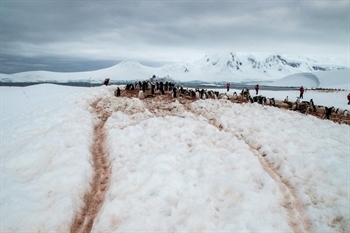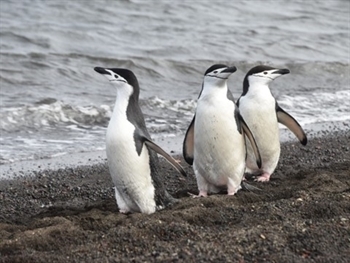
Audrey Wennink
There is no public transit in Antarctica. No roads, or rails or anything other than ships and air transport planes. There are, however, “penguin highways” -- brown trails between colonies where penguins waddle from one huddled group to another. And there is actually a significant connection between penguins and the buses and trains we ride in cities all over the world.

Audrey Wennink
Penguin Highway in Antartica
Having always been fascinated with Antarctica and its history of exploration, I had an opportunity to travel there myself in December 2022. Departing from Ushuaia, Argentina (the southernmost city on the planet) we traveled for 2.5 days on a ship through the Drake Passage to reach the Antarctic Peninsula. Once there, we spent 5 days getting off the boat once or twice a day via inflatable Zodiac boat to land on rocky, icy islands inhabited by penguins and seals. Or sometimes we cruised the bays in flat black boats to see animals that live on chunks of floating ice. It’s summer there when it’s winter in Chicago, with temperatures around 32 degrees most days.

Audrey Wennink
The expansive blue and white landscape sparkled under bright sun, and other days icebergs floated by in moody shades of gray. Penguins, seabirds, whales and elephant seals roamed about on rocky islands and icebergs. While it’s a harsh landscape, especially for humans, we learned that it’s also a very fragile one. In between excursions, our guides ranging from ornithologists to marine mammal specialists gave lectures on how the native species live, feed and reproduce in Antarctica.

Audrey Wennink
The continent is covered with glaciers and surrounded by sea ice that most animals depend on to survive. Whenever an ice shelf disintegrates, the speed of glaciers sliding into the ocean accelerates. This is called the positive feedback effect. Temperatures in Antarctica are already an average of 2 degrees Celsius higher than 70 years ago now, and they reached a new high of 69 degrees Fahrenheit in February 2020. In August 2023, the New York Times reported that Antarctica’s sea ice level is far below what is normal.
Antarctica is gorgeous - pure magic. Its stability is also critical to the world’s stability. To reduce impacts to this icy paradise, we need to concern ourselves with our daily life back at home. Given the connection between transportation and climate change – transportation is the # 1 contributor to GHG emissions -- we need to be aggressively changing our transportation systems and our behavior to sharply reduce our impacts.
On the last slide of the presentation on how climate change is impacting Antarctica, the instructor mentioned transportation as a solution multiple times.
Her instructions to ride transit more and travel sustainably overall jolted me back to the daily lives we lead in the Chicago region. And how we battle to make our system more appealing and safer for those biking, walking and using transit. I hope one day you too get to visit Antarctica. But remember in the meantime, how you travel daily is affecting the last truly wild place on earth. If nothing else, ride transit for the adorable penguins.